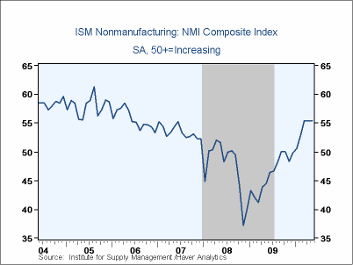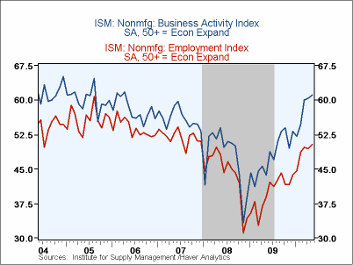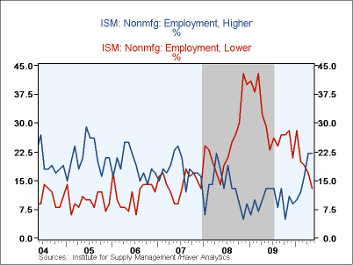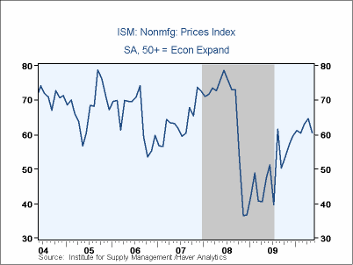 Global| Jun 03 2010
Global| Jun 03 2010U.S. ISM Nonmanufacturing Index Is Unchanged But Job Growth At New High
by:Tom Moeller
|in:Economy in Brief
Summary
The rate of expansion in service sector activity has been steady this Spring. The Institute for Supply Management's (ISM) Composite Index for the service & construction sectors during May held at 55.4 for the third month, though that [...]


The rate of expansion in service sector activity has been steady this Spring. The Institute for Supply Management's (ISM) Composite Index for the service & construction sectors during May held at 55.4 for the third month, though that still was the highest level since early-2006. In addition, the series has risen considerably from a low of 37.2 late in 2008. The latest figure roughly matched Consensus expectations for a reading of 55.7. Since the series' inception in 1997 there has been a 65% correlation between the level of the composite index in the nonmanufacturing sector and the q/q change in real GDP for the services and the construction sectors.
The employment index posted a gain to 50.4, its first month above the break-even level since December 2007. Twenty-two percent of respondents reported increased hiring while 13% reported fewer jobs. Since the series' inception in 1997 there has been an 80% correlation between the level of the ISM nonmanufacturing employment index and the m/m change in payroll employment in the service-producing plus the construction industries. The business activity index also rose m/m but new orders fell. Thirty-five percent of respondents reported higher orders while only 13% reported them lower. Vendor delivery speeds sped up marginally m/m but they're much slower than early last year.
The pricing power index slipped to 60.6 but remained up sharply from the 2008 low. Thirty-five percent of respondents reported higher prices while 5% reported them lower. At the worst, late in 2008, 41% reported lower prices. Since its inception ten years ago, there has been a 73% correlation between the price index and the q/q change in the GDP services chain price index.
Beginning with the January 2008 Nonmanufacturing Report On Business ®, the composite index is calculated as an indication of overall economic conditions for the non-manufacturing sector. It is a composite index based on the diffusion indices of four of the indicators (business activity, new orders, employment and supplier deliveries) with equal weights. The latest report from the ISM can be found here.
| ISM Nonmanufacturing Survey | May | April | March | May '09 | 2009 | 2008 | 2007 |
|---|---|---|---|---|---|---|---|
| Composite Index | 55.4 | 55.4 | 55.4 | 44.5 | 46.2 | 47.3 | 53.5 |
| Business Activity | 61.1 | 60.3 | 60.0 | 43.6 | 48.0 | 47.4 | 56.0 |
| New Orders | 57.1 | 58.2 | 62.3 | 45.4 | 47.9 | 47.0 | 54.8 |
| Employment | 50.4 | 49.5 | 49.8 | 38.9 | 39.9 | 43.8 | 52.0 |
| Supplier Deliveries (NSA) | 53.0 | 53.5 | 49.5 | 50.0 | 49.0 | 51.1 | 51.1 |
| Prices Index | 60.6 | 64.7 | 62.9 | 47.4 | 49.4 | 66.0 | 63.8 |
Tom Moeller
AuthorMore in Author Profile »Prior to joining Haver Analytics in 2000, Mr. Moeller worked as the Economist at Chancellor Capital Management from 1985 to 1999. There, he developed comprehensive economic forecasts and interpreted economic data for equity and fixed income portfolio managers. Also at Chancellor, Mr. Moeller worked as an equity analyst and was responsible for researching and rating companies in the economically sensitive automobile and housing industries for investment in Chancellor’s equity portfolio. Prior to joining Chancellor, Mr. Moeller was an Economist at Citibank from 1979 to 1984. He also analyzed pricing behavior in the metals industry for the Council on Wage and Price Stability in Washington, D.C. In 1999, Mr. Moeller received the award for most accurate forecast from the Forecasters' Club of New York. From 1990 to 1992 he was President of the New York Association for Business Economists. Mr. Moeller earned an M.B.A. in Finance from Fordham University, where he graduated in 1987. He holds a Bachelor of Arts in Economics from George Washington University.








